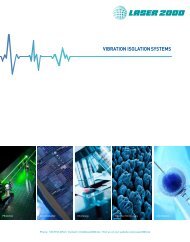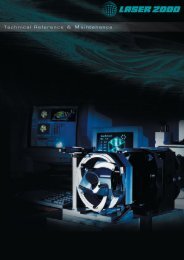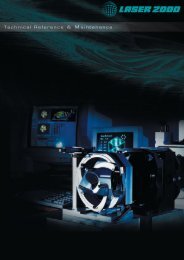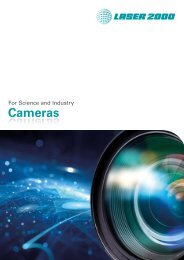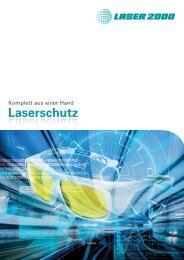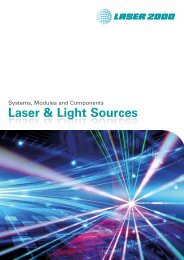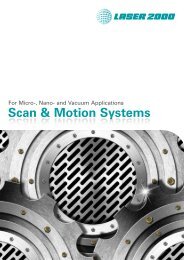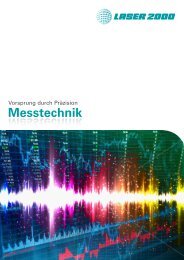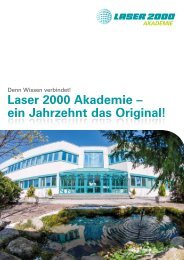Semrock Master Catalog 2018
Semrock Master Catalog 2018
Semrock Master Catalog 2018
You also want an ePaper? Increase the reach of your titles
YUMPU automatically turns print PDFs into web optimized ePapers that Google loves.
Multiphoton Filters Common Specifications<br />
Common Specifications<br />
Property Emitter LWP Dichroic Comment<br />
Passband<br />
Transmission<br />
Guaranteed > 90% > 93% Averaged over any 50 nm (emitter) or 10 nm<br />
Typical > 95% > 95%<br />
(dichroic) window within the passband. For SWP<br />
dichroic specifications, see page 44 .<br />
Dichroic Reflection LWP N/A > 98% Averaged over any 30 nm window within the reflection<br />
band. For SWP dichroic specifications, see page 44.<br />
Autofluorescence Ultra-low Ultra-low Fused silica substrate<br />
Blocking<br />
Pulse Dispersion<br />
Emitter Orientation<br />
Dichroic Orientation<br />
Emitter filters have exceptional blocking over the Ti:Sapphire laser range as needed to achieve superb<br />
signal-to-noise ratios even when using an extended-response PMT or a CCD camera or other siliconbased<br />
detector.<br />
LWP dichroic beamsplitters are suitable for use with 100 femtosecond Gaussian laser pulses. For SWP<br />
dichroic beamsplitters, see Group Delay Dispersion and Polarization Technical Note at<br />
www.semrock.com<br />
The emitter orientation does not affect its performance; therefore there is no arrow on the ring to<br />
denote a preferred orientation.<br />
For the LWP dichroic, the reflective coating side should face toward detector and sample. For the SWP<br />
dichroic, the reflective coating side should face towards laser as shown in the diagram on page 27.<br />
Fluorophores<br />
Single-band<br />
Sets<br />
Multiband<br />
Sets<br />
Microscope Compatibility<br />
These filters fit most standard-sized microscope cubes from Nikon, Olympus, and Zeiss and may<br />
also be mounted in optical bench mounts. Contact <strong>Semrock</strong> for special filter sizes.<br />
Cubes<br />
TECHNICAL NOTE<br />
Multiphoton Filters<br />
In multiphoton fluorescence microscopy, fluorescent molecules that<br />
tag targets of interest are excited and subsequently emit fluorescent<br />
photons that are collected to form an image. However, in a two-photon<br />
microscope, the molecule is not excited with a single photon as it is in<br />
traditional fluorescence microscopy, but instead, two photons, each<br />
with twice the wavelength, are absorbed simultaneously to excite<br />
the molecule.<br />
Ti:Sapphire<br />
Laser<br />
Source<br />
Laser Beam<br />
Scan Head<br />
Dichroic Beamsplitter<br />
Emitter Filter<br />
Figure 1: Typical<br />
configuration of<br />
a multiphoton<br />
fluorescence<br />
microscope<br />
Laser<br />
Sets<br />
NLO<br />
Filters<br />
As shown in Figure 1, a typical system is comprised of an excitation<br />
laser, scanning and imaging optics, a sensitive detector (usually a<br />
photomultiplier tube), and optical filters for separating the fluorescence<br />
from the laser (dichroic beamsplitter) and blocking the laser light from<br />
the detector (emission filter).<br />
The advantages offered by multiphoton imaging systems include: true<br />
three-dimensional imaging like confocal microscopy; the ability to image<br />
deep inside of live tissue; elimination of out-of-plane fluorescence; and<br />
reduction of photobleaching away from the focal plane to increase<br />
sample longevity. Now <strong>Semrock</strong> has brought enhanced performance<br />
to multiphoton users by introducing optical filters with ultra-high<br />
transmission in the passbands, steep transitions, and guaranteed deep<br />
blocking everywhere it is needed. Given how much investment is<br />
typically required for the excitation laser and other complex elements<br />
of multiphoton imaging systems, these filters represent a simple and<br />
inexpensive upgrade to substantially boost system performance.<br />
Depth 100 µm<br />
Sample<br />
Detector<br />
x-z projection x-y images y-z projection<br />
1<br />
2<br />
Individual<br />
Filters<br />
Dichroic<br />
Beamsplitters<br />
Exciting research using <strong>Semrock</strong> multiphoton filters demonstrates the power of<br />
fluorescent Ca 2+ indicator proteins (FCIPs) for studying Ca 2+ dynamics in live cells using<br />
two-photon microscopy. Three-dimensional reconstructions of a layer 2/3 neuron<br />
expressing a fluorescent protein CerTN-L15. Middle: 3 selected images (each taken<br />
at depth marked by respective number on the left and right).<br />
Image courtesy of Prof. Dr. Olga Garaschuk of the Institute of Neuroscience at<br />
the Technical University of Munich. (Modified from Heim et al., Nat. Methods,<br />
4(2): 127-9, Feb. 2007).<br />
1<br />
2<br />
3<br />
Depth 260 µm<br />
3<br />
1<br />
2<br />
3<br />
Tunable<br />
Filters<br />
47<br />
More



